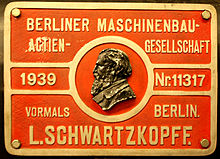



Berliner Maschinenbau AG was a German manufacturer of locomotives.
Contents
The factory was founded by Louis Victor Robert Schwartzkopff on 3 October 1852 as Eisengießerei und Maschinen-Fabrik von L. Schwartzkopff in Berlin.




Berliner Maschinenbau AG was a German manufacturer of locomotives.
The factory was founded by Louis Victor Robert Schwartzkopff on 3 October 1852 as Eisengießerei und Maschinen-Fabrik von L. Schwartzkopff in Berlin.
The factory was founded on 3 October 1852 as Eisengießerei und Maschinen-Fabrik von L. Schwartzkopff in Berlin by Louis Victor Robert Schwartzkopff. After a fire in 1860 and the expansion of the factory, they started to manufacture turntables, water systems and turnouts for several railway companies. The first locomotive built by the firm was delivered on 1 February 1867 to the Lower Silesian-Mark Railway (Niederschlesisch-Märkische Eisenbahn or NME). On 1 July 1870 the firm was turned into a share company and renamed the Berliner Maschinenbau-Actien-Gesellschaft vormals L. Schwartzkopff, Berlin. [1] In 1897 a second factory was opened in Wildau. From 1899 the company also manufactured Linotype machines for the Mergenthaler factory in Berlin. On 4 July 1907 they started a joint venture with the Munich firm of Maffei. For that purpose the Maffei-Schwartzkopff-Werke GmbH was opened next to the existing factory in Wildau. It was here that the construction of electric locomotives and their equipment began in 1910. In 1924 diesel locomotives followed. In 1932 the Maffei-Schwartzkopff-Werke went bankrupt.
In 1945, following the destruction of the factory halls during the Second World War and the dismantling of other parts of the factory in Berlin and Wildau, the construction of locomotives by the Berliner Maschinenbau finally ended. On 20 September 1945 the production of cast iron components, linotype machines and glass-blowing machines started up in the remaining parts of the factory. In 1961 the tractor firm of Moorburger Treckerwerke was bought and its production changed. In 1966 the Berliner Maschinenbau was merged into the DIAG, the Deutsche(n) Industrieanlagen Gesellschaft mbH. [2]
The Berliner Maschinenbau was involved in the construction of the following locomotives:
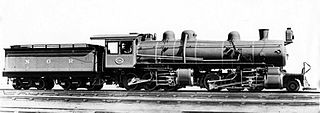
Under the Whyte notation for the classification of steam locomotives by wheel arrangement, 2-6-6-0 is a locomotive with one pair of unpowered leading wheels, followed by two sets of three pairs of powered driving wheels and no trailing wheels. The wheel arrangement was principally used on Mallet-type articulated locomotives. Some tank locomotive examples were also built, for which various suffixes to indicate the type of tank would be added to the wheel arrangement, for example 2-6-6-0T for an engine with side-tanks.

In Whyte notation for the classification of steam locomotives by wheel arrangement, an 0-4-4-2 is a locomotive that has no leading wheels, two sets of four driving wheels and two trailing wheels.

The Deutsche Reichsbahn's Class 52 is a German steam locomotive built in large numbers during the Second World War. It was the most produced type of the so-called Kriegslokomotiven or Kriegsloks. The Class 52 was a wartime development of the pre-war DRG Class 50, using fewer parts and less expensive materials to speed production. They were designed by Richard Wagner who was Chief Engineer of the Central Design Office at the Locomotive Standards Bureau of the DRG. About a dozen classes of locomotive were referred to as Kriegslokomotiven; however, the three main classes were the Class 52, 50 and 42. They were numbered 52 1-52 7794. A total of 20 are preserved in Germany.

Johann Karl Friedrich August Borsig was a German businessman who founded the Borsig-Werke factory.

The Technical University of Applied Sciences Wildau is the largest of five universities of applied sciences in the federal state of Brandenburg, Germany. TH Wildau was founded as a technical university of applied sciences in 1991, but its connection to engineering education dates back further to the late 1940s. Today it sits on a modern and compact campus, with direct S-Bahn access to Germany's capital city, Berlin.

Kriegslokomotiven or Kriegsloks were locomotives produced in large numbers during the Second World War under Nazi Germany. Their construction was tailored to the economic circumstances of wartime Germany along with conquered and occupied territories across Europe, taking account of the shortage of materials, the transportation of goods in support of military logistics, ease of maintenance under difficult conditions, resistance to extreme weather, limited life and the need for rapid, cheap mass production. In order to meet these requirements, economic drawbacks such as relatively high fuel consumption had to be accepted. Forced labour was used in the construction of some of the locomotives; German locomotive building firms employed prisoners from concentration camps and foreign, mostly Polish, workers.
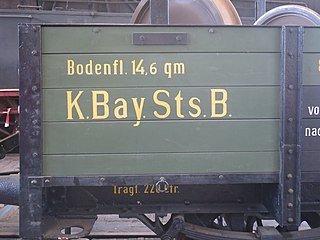
The Royal Bavarian State Railways was the state railway company for the Kingdom of Bavaria. It was founded in 1844. The organisation grew into the second largest of the German state railways with a railway network of 8,526 kilometres by the end of the First World War.

The Prussian Class P 8 of the Prussian state railways was a 4-6-0 steam locomotive built from 1906 to 1923 by the Berliner Maschinenbau and twelve other German factories. The design was created by Robert Garbe. It was intended as a successor to the Prussian P 6, which was regarded as unsatisfactory.
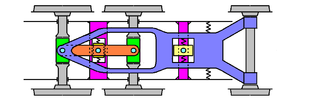
A Schwartzkopff-Eckhardt bogie is a mechanical device to improve the curve running of steam locomotives.

The Prussian T 18 was the last class of tank locomotives developed for the Prussian state railways. They were originally intended for services on the island of Rügen as replacements for Class T 12 and T 10 engines. They emerged when a class of locomotive was conceived in 1912 that was to handle express and passenger trains in border areas or in shuttle services on short routes. A tank engine design with symmetrical running gear was envisaged because, unlike a tender locomotive, it could run equally fast forwards and backwards and could be operated on return journeys without having to be turned on a turntable. Its power and top speed were to be the same as those of the P 8. Robert Garbe designed this 4-6-4 (2′C2′) tank locomotive for 100 km/h with a 17-ton axle load and contracted the Vulkan Werke in Stettin to build it. It was given the designation T 18.

The Schichau-Werke was a German engineering works and shipyard based in Elbing, Germany on the Frisches Haff of then-East Prussia. It also had a subsidiary shipyard in nearby Danzig. Due to the Soviet conquest of eastern Germany, Schichau moved to Bremerhaven in March 1945, and its successors continued in business until 2009.

The Sächsische Maschinenfabrik in Chemnitz was one of the most important engineering companies in Saxony in the second half of the 19th century and the first two decades of the 20th century. Including its various predecessor businesses, the firm existed from 1837 until its liquidation in 1930, and individual branches of the company taken over by others continued to operate until 1990. The company is closely linked with the name of its founder and long-time manager, Richard Hartmann, whose name formed part of the new company title in 1898: the Sächsische Maschinenfabrik vormals Richard Hartmann.
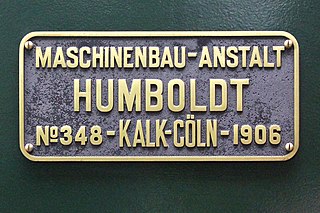
The Maschinenbauanstalt Humboldt was a German mechanical engineering firm in Cologne-Kalk and a precursor to the firm of Deutz AG. It was founded in 1871 as Maschinenbau A.G. Humboldt, liquidated due to debts in 1884 and reformed as Maschinenbauanstalt Humboldt A.G..

The Baden VI b was the first German tank locomotive with a 2-6-2 wheel arrangement. It was developed by the firm of Maffei for the Grand Duchy of Baden State Railways in order to provide faster services on the Höllentalbahn. As a result, the first six batches were given a firebox sloping to the rear. One striking feature was also the connecting pipe between the two steam domes.
The Prussian state railways grouped a variety of different types of passenger tank locomotive into its Prussian Class T 5. Several examples of the sub-classes T 5.1 and T 5.2 transferred into the Deutsche Reichsbahn as DRG Classes 71.0 and 72.0.
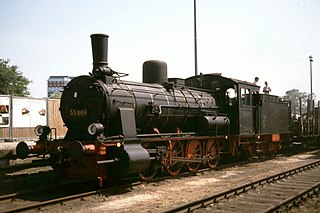
The Prussian Class G 7.1 engines of the Prussian state railways were German eight-coupled, goods train, steam locomotives.
Friedrich Wilhelm Eckhardt was a German engineer and head of the design office for the Berliner Maschinenbau Aktien Gesellschaft vormals L. Schwartzkopff.
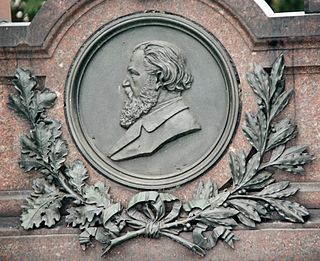
Louis Victor Robert Schwartzkopff was a German industrialist and founder of the Berliner Maschinenbau (BMAG) mechanical engineering company, chiefly known as manufacturer of steam locomotives.
The Schwartzkopff torpedo was a torpedo manufactured in the late 19th century by the German firm Eisengießerei und Maschinen-Fabrik von L. Schwartzkopff, later known as Berliner Maschinenbau, based on the Whitehead design. Unlike the Whitehead torpedo, which was manufactured out of steel, the Schwartzkopff was made out of bronze, enhancing corrosion resistance.